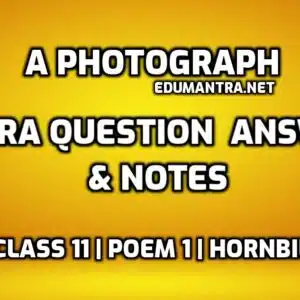
Welcome to our extra questions guide on Chapter A Photograph. We have everything you need. Want a summary? We have that and even a summary example. We also have multiple choice questions, or MCQs. Hard words in the chapter. We explain difficult words in English too. You’ll get an introduction in English to start you off. We offer both long and short question answer in English. We also give you a personality sketch of the author. Want to dive into themes? We have that. We even have a comprehension passage with question and answer. Get ready to learn this chapter well!
Extra Questions, Notes, Assignment and study material for Class 11th as Per CBSE Syllabus
Chapter- 1.1 English
A Photograph Class 11 Extra Questions and Answers
By- Shirley Toulson
Table of Contents
Introduction of the lesson- A Photograph
Following is the introduction English text for Chapter ‘A Photograph Class 11,’ aimed to give you a clear grasp of its main ideas.”

The poem captures three different moods and situations in three stanzas. The first one tells about a snapshot or an instant cardboard-photo of three girls. They are cousins. The eldest one, 12 years old, became the mother of the poetess after marriage. They are enjoying a sea holiday, putting on funny dresses. Their uncle clicks the camera and captures the smiling faces of all the three.
Some 20-30 years later, the mother looks at the photo and laughs. She tells the poetess how her cousins Betty and Dolly had all dressed for the holiday. The outing on the beach in a quaint dress was the mother’s past. But her laughter has become a thing of the past for the poetess. The mother passed away some twelve years ago. The void created by her death has made life dull and eventless.
Hard Words : A Photograph Page No.- 11
“Here, we provide the word meaning with Hindi, page-wise, for hard words and difficult words in English found in the chapter ‘A Photograph Class 11.‘ Our guide offers good word meaning to help you understand the text better.”
Paddling = wading, splashing (पानी में पैर मारना), Transient = fleeting, temporary (अल्पकालिक), Snapshot = photo, picture (तस्वीर), Dressed = clothed, attired (पहनावा),
Beach = seashore, coastline (समुदर का किनारा), Wry = twisted, skewed (तेढ़ा), Laboured = effortful, strained (मेहनत से किया गया), Circumstance = situation, scenario (परिस्थिति)
Short and Simple Summary of the lesson in English- A Photograph
Take a look at the following summary example to better understand the chapter “A Photograph,” crafted through careful summary writing.

The poetess looks at the photograph of her late mother, with her two cousins on a sea beach. The mother was the eldest of the three, 12 years old, and had a lovely face. They were escorted by the uncle, who clicked the camera. The girls stood in shallow water. The sea waves seemed to be washing their feet which changed fast with the passage of time. Only the sea has shown no change in its behaviour over the years.
The mother happened to see her photo after a time-gap of some 20-30 years. She was amused to see the pretty, beach dresses of all the three girls. She blushed and laughed. She told the poetess that they had been dressed for the pleasure trip by her cousins Betty and Dolly.
The sea holiday was the mother’s past, but after she had passed away, her laughter became a thing of the past for the poetess. Both had lost their newness with the passing of time. The photograph is twisted and faded; the memory of the mother’s laughter has also grown faint.
The mother of the poetess died some 12 years ago. The poetess has faced only blank silences after her mother’s death. She has nothing to say about that period since the mother left.
Summary in Hindi/ A Photograph
Here is the Hindi story summary of the chapter “A Photograph Class 11,” designed to give you a clear understanding of its essential ideas in Hindi.
कवयित्री अपनी दिवगंत माँ को चचेरी बहनों के साथ समुद्रतट पर खींची गई एक फोटो में दिखती है उस समय माँ की आयु मात्र 12 वर्ष थी; वही तीनों में ज्येष्ठ थी तथा उसका चेहरा भी सुन्दर था I उसके साथ गए थे अंकल जिन्होंने कैमरे से फोटो खींचीं थी I तीनों बहनें उथले पानी में खड़ी थी I समुद्र की लहरें जैसे उनके पाँव-पाखर रही थीं I ये पाँव तो वेग से समय के साथ साथ आकार आदि में बदल गए, पर समुद्र के व्यवहार में इतने वर्षों में कोई परिवर्तन नहीं आया I

माँ ने संयोग से वही फोटो शादी के 20-30 वर्ष पश्चात् देखी I वह हँसी न रोक सकी क्योंकि तीनों बहनों ने विचित्र वस्त्र पहन रखे थे I वह लजा गई तथा हँस दी I उसने अपनी बेटी कवयित्री को बताया कि इस अवसर के लिए उसकी दोनों चचेरी बहनों, बेटटी तथा डॉली ने ही उनके वस्त्रों का चयन किया था I
वह समुद्र तट की घटना तो माँ का अतीत बन गई थी पर उसकी मृत्यु के उपरांत उसकी हँसी ही कवयित्री के लिए इतिहास की एक घटना बन गई दोनों ही समय के थपेड़े खाकर अपना नया ताजापन खो चुके थे I फोटो में सिकुड़न आ गई थी तथा फीकी पड़ गई थी I माँ की हंसी की याद भी अब तक मंद पड़ गई थी I
कवयित्री की माँ का निधन कोई 12 वर्ष पूर्व हो गया था कवयित्री ने माँ के जाने के पश्चात् केवल खाली सन्नाटा ही भोगा है I माँ के स्वर्गवास के पश्चात् के इस समय के बारे में उसके पास कहने लायक कुछ भी नहीं है I
Following is the complete question bank for A Photograph
Read the stanza carefully and answer the questions that follow :
The cardboard shows me how it was
When the two girl cousins went paddling,
Each one holding one of my mother’s hands
And she the big girl—some twelve years or so.
Word-Notes
cardboard–the instant photo that comes out of the camera. It has the hard base of a cardboard; how it was–the situation at that time; paddling–walking with short steps on water, propelling a small boat for sport on water (पैर से चलाई जाने वाली नाव),संभलकर पानी में चल रही थी; holding–थामे हुए; big girl–the mother of the poetess, was then only twelve years old.
कवयित्री एक पुरानी फोटो देख रही है जब उसकी माँ अविवाहित थी, 12 वर्ष की थी I वह अपनी दो छोटी चचेरी बहनों के साथ समुद्रतट पर सैर करने गई थी; वहाँ वे उथले पानी में संभल-संभलकर चल रही थी I कवयित्री की माँ उन तीनों में सबसे बड़ी आयु की थी, बारह वर्ष की I
Questions
(i) What does the word ‘cardboard’ denote in the poem? Why has this word been used?
(ii) Who were the three girls captured in the photograph?
(iii) Where had they gone for outing/paddling?
Ans.
(i) The word ‘cardboard’ denotes the instant photo or snapshot that is pasted on cardboard in the photo frame.
(ii) The three girls captured in the photograph were the mother of the poetess who was not married then, and her two cousins—Betty and Dolly.
(iii) They had gone out for a sea holiday. They were photographed on the sea beach.
(2)
All three stood still to smile through their hair
At the uncle with the camera. A sweet face,
My mother’s, that was before I was born.
And the sea, which appears to have changed less,
Washed their terribly transient feet.
Word-Notes
all three—the poetess’ mother and her two cousins; still—motionless; smile through their hair—with some hair strands falling over their eyes and face; a sweet face—the mother of the yet-unborn poetess looked charming with her innocent face; changed less—the sea over the years hasn’t changed at all or very little; washed—touched, पखार रहा था ; terribly—greatly, at fast speed; transient—unsteady, moving,चंचल I
वे तीनों लड़कियाँ कवयित्री की माँ जो उस समय मात्र 12 वर्ष की थी तथा अविवाहित थी तथा उसकी दो मौसेरी बहनें, खड़ी होकर चेहरे पर लटके कुछ बालों के पीछे से मुस्कुरा रही थी I सामने उनके चाचा कैमरा लिए फोटो खींच रहे थे I माँ का चेहरा अति सुन्दर था I यह बात उस समय की है जब कवयित्री का जन्म नहीं हुआ था और समुद्र की लहरें उन तीनों के चंचल, अस्थिर पैरों को पखार रही थी लड़कियों के पैरों की तो शक्ल बदल गई, पर समुद्र की लहरों में कोई परिवर्तन नहीं आया है I
Questions
(i) What does ‘three’ refer to?
(ii) When and where was the photograph taken?
(iii) Bring out the comparison between the sea and the ‘feet’.
Ans.
(i) The ‘three’ are Betty, Dolly and the mother of the poetess.
(ii) The photograph was taken on the sea beach by the uncle.
(iii) The sea is unchanging while human feet being washed by the sea waves are fast changing.
(3)
Some twenty-thirty—years later
She’d laugh at the snapshot. “See Betty
And Dolly,” she’d say, “and look how they
dressed us for the beach.”
Word-Notes
she–the mother of the poetess; snapshot–the photo; laugh at–finds her dress and appearance funny; Betty and Dolly–the two cousins; dressed us–put on a casual dress for the outing on the sea beach; beach–the three cousin sisters had gone to the sea beach for an outing or holiday
जब वह फोटो खींची गई थी उसके 20-30 वर्ष पश्चात, माँ अपनी बेटी कवयित्री को फोटो दिखाकर हँस देती है I वह बताती है कि देखो मेरी बहनों बेटटी तथा डॉली ने हम सब को किस प्रकार के अजीब कपड़े पहना दिए थे I (स्वयं को उस भड़कीली वेशभूषा में देखकर माँ को लाजवश हँसी आ जाती है I)
Questions
(i) The poetess’ mother laughed at the snapshot. Why? What did her laugh indicate?
(ii) When was the snapshot taken?
(iii) Who had dressed the speaker? What was funny about the dress?
Ans.
(i) The mother of the poetess was at that time some twelve years old. Now after 20-30 years, the mother cannot help laughing at her own picture in a casual, holiday costume.
(ii) The snapshot was taken on the sea beach by the poetess’ uncle some 20-30 years ago.
(iii) The poetess’ mother had been dressed for the holiday by her two cousins—Betty and Dolly. All the three were dressed in girlish beach dresses.
(4)
The sea holiday
Was her past, mine is her laughter. Both wry
With the laboured ease of loss.
Word-Notes
sea holiday–an outing for pleasure, for merry-making on the sea beach. The three girls were escorted by their uncle who carried a camera to shoot their photos. The photo was some 30 years old. The poetess’ mother showed it to her own laughter, the poetess; was her past–the sea-holiday represented the mother’s childhood, a long time ago. mine is her laughter–the mother passed away. The poetess on seeing the same photo years after mother’s death feels sad. She misses the mother’s laughter; wry–sad, disappointed; both–the photo as well as the poetess; laboured ease of loss–both had suffered the ravages of time and bore the loss. The photo is fading and the poetess’ has learnt to bear the loss of her mother with the passing of time.
जब तीनों बहनें समुद्र तट पर मौज-मस्ती के लिए चाचा के साथ गई थीं, उस घटना को बीते हुए 20-30 वर्ष हो चुके थे I इसलिए वह कवयित्री की माँ के लिए अतीत की बात हो चुकी थी I पर उस चित्र में अपनी वेशभूषा को देखकर माँ हंस दी थी; उस हंसी को बीते भी अनेक वर्ष हो चुके हैं I वह हँसी अब कवयित्री के लिये अतीत की घटना बन गई है I वह फोटो तथा वह हँसी—दोंनों ही मंद पड़ चुकी हैं I
Questions
(i) What is the significance of the ‘sea holiday’ here?
(ii) Explain: The sea holiday was her past, mine is her laughter.
(iii) Who does ‘both’ here refer to?
Ans.
(i) The significance of the sea holiday is that the mother was also a girl once and it refers to a happy moment in her life on the sea beach.
(ii) The mother had seen her photo, taken 20-30 years earlier when she was just twelve years old. So, that photograph denoted her own past. But the poetess who had heard her mother laugh is also bereaved. The mother has passed away, her laughter is also thing of the past for the poetess.
(iii) ‘Both’ here refers to the photograph and the mother’s laughter.
(5)
Now she’s been dead nearly as many years
as that girl lived. And of this circumstance
There is nothing to say at all.
Its silence silences.
Word-Notes
she—the mother of the poetess. She passed away some 12 years ago; this circumstance—the period after the death of the mother, the loss and grief of the poetess; there is nothing to say at all—life has been dull and eventless after the mother’s death. The void created by her death is slowly becoming less painful. Time which passes silently but steadily weakens old memories of loss and grief.
अब तो माँ को गुजरे हुए भी लगभग उतना ही समय बीत चुका है जितनी बड़ी उस फोटो में दिख रही थी I उसकी मृत्यु द्वारा हुई क्षति और दुख के बारे में भी अब कहने को क्या रह गया है I समय ने चुपके से उन पुरानी यादों तथा दुखों को धुंधला कर दिया है I अब उन्हें याद करने से कोई लाभ नहीं I समय सब दुखों को भुला देता है I
Questions
(i) How many years ago had the poetess’s mother died?
(ii) What does ‘this circumstance’ refer to?
(iii) Explain Its silence silences.
Ans.
(i) It is some 12 years since the poetess’s mother passed away.
(ii) ‘This circumstance’ refers to the death of the mother.
(iii) The mother’s voice has been silenced forever. The photo cannot laugh. The poetess also feels depressed and speechless.
Very Short Answer Type Important Questions – A Photograph
1. What did the cardboard picture capture?
Ans. The cardboard snapshot captured the happy faces of three cousins enjoying a sea-holiday.
2. What do you think made the poetess’s mother laugh?
Ans. He looks at the age of 12 and her pretty beach dress as captured in the photo made her laugh.
3. When and where were the three cousins photographed?
Ans. The three girls were photographed by their uncle on the sea beach. They had gone there on a pleasure trip. They stood in the shallow water with sea waves washing their feet.
4. What does the poetess mean by ‘their terribly transient feet’?
Ans. The dictionary meaning of the word transient is brief and fleeting. The three girls were at a growing age. They underwent notable changes as time passed. But the sea suffered no change over the years. The expression highlights the contrast between mortal man and timeless, ageless sea.
5. Explain: The sea holiday was her past, mine is her laughter.
Ans. The determiner ‘her’ at both places refers to the poetess’s mother. The picture taken during the sea holiday 20-30 years ago made the mother laugh. Her sea holiday was her past. But twelve years after the mother’s death, her laughter has now become a thing of the past for the poetess.
6. Now she’s been dead nearly as many years as that girl lived. How many years have passed since the mother’s death?
Ans. Twelve years have passed since the mother’s death.
7. Explain Its silence silences.
Ans. The period of nearly twelve years since the poetess’s mother passed away, has been painful for the poet. She can not hear her laughter anymore. There is only silence now and the poet has to bear her loss in silence.